Neurosen der Präzision
(Tuned City, Berlin _iii)
(( --> [ _o ] [ _one. ] [ _two. ] [ _three. ] [ _four. ] [ _five. ] [ _six. ] || [ found ] ))
november 12, 2008.
So the next day, wednesday, was even better. Or worse. The temperature
in Berlin had risen further. There were other, more and new dramatic
twists in Sturm der Liebe, and meanwhile it had become crystal
clear to me, as if by revelation, that Sturm der Liebe would
set the theme for the Diktat
big band performance that we had planned at La Comète in Paris, ten days
from then, on the 13th of july.
Goedschiks of kwaadschiks.
When on wednesday we arrived
in Mitte it was even later.
That was at the Staalplaat/le Petit Mignon store, in the Torstraße.
After walking for over two hours under a slowly setting but no less relentless sun, of course we had to sit down for a while. We had to have something to drink. We did both at the small table that stood in the middle of the shop's front space. It was covered with an immaculate white paper tablecloth, on which there were one or two phrases, handwritten with a black pen. After a while this made us realize that the white tablecloth was meant to be written upon. It actually was Brandon Labelle's, who wanted visitors to leave him their radio memories, that is: memories of moments, places or events somehow intimately linked to or marked by a song or other piece of music which was then playing through the radio, or maybe even otherwise.
Brandon put out a
call for such memories in 2005; recently a selection appeared (in english)
as Radio
Memory (Audio Issues).
The book's cover is a picture of a tablecloth like the one on the table at Staalplaat's. (See the picture below; click to enlarge.)
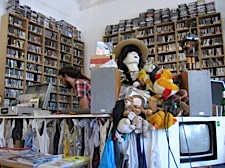 |
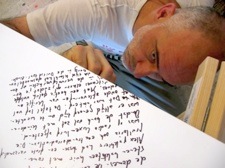 |
Radio Memory is similar in spirit to José van Dijcks archival project, based upon the thousands of messages that are left by listeners on the website of the yearly 'Top 2000', a hugely popular dutch national radio program, broadcast throughout each last month of the year since 1999. All of these dutch 'radio memories' though of course are written in ... dutch ... hence maybe not so easy to access for non-dutch speakers ...
In the picture above you see Rinus van Alebeek in the process of jotting
down a black radio memory on Brandon Labelle's white tablecloth at Staalplaat's
on the early evening of wednesday july 3th of this year. He wrote it in
dutch. "Kapper Alex Pakbiers leek op een gitarist van de Shadows ..."
the story begins ( * ) ... ![]() You will hear rinus reciting this 'radio memory' towards the end of "Some
sounds are like shadows", the second in the series of radio-dicta-phonic
sound reports that together form the 14th edition of Raudio's mainstream,
documenting my stay at Neukölln, Tuned City and das kleine. There's also
some other sounds from our resting hours at Le Petit Mignon that wednesday,
including our meeting with a charming japanese girl/musician, who walked
into the shop, and began turning around 'our' table. When we asked her,
whether she had come to Berlin for the Tuned City festival, she told us
that she "knew the festival since coming", but that she also made
music herself, with "noise and voice and software synthesizer"
...
You will hear rinus reciting this 'radio memory' towards the end of "Some
sounds are like shadows", the second in the series of radio-dicta-phonic
sound reports that together form the 14th edition of Raudio's mainstream,
documenting my stay at Neukölln, Tuned City and das kleine. There's also
some other sounds from our resting hours at Le Petit Mignon that wednesday,
including our meeting with a charming japanese girl/musician, who walked
into the shop, and began turning around 'our' table. When we asked her,
whether she had come to Berlin for the Tuned City festival, she told us
that she "knew the festival since coming", but that she also made
music herself, with "noise and voice and software synthesizer"
...
Sometime between 20h and 20h30 we left Staalplaat/Le Petit Mignon,
and for the second day in succession we embarked upon our long
march back to Neukölln.
Now let me tell you that it was not easy. But again it was pretty interesting. This second walk
actually quite naturally divided itself into a number of successive stages ...
° The first stage lead to food.
 Rinus
said we would pass a place that'd serve us a pretty mean 'n' original
german Bockwurst for dinner. Unfortunately, as the particular place that he had in mind
turned out to be closed, we had to settle for some noodle plate at a chinese's
just around the corner. Now that of course was a bit of a disappointment, but on the other hand ... also not too much, really. At the time I could have eaten
anything really and be happy with it ...
Rinus
said we would pass a place that'd serve us a pretty mean 'n' original
german Bockwurst for dinner. Unfortunately, as the particular place that he had in mind
turned out to be closed, we had to settle for some noodle plate at a chinese's
just around the corner. Now that of course was a bit of a disappointment, but on the other hand ... also not too much, really. At the time I could have eaten
anything really and be happy with it ...
° The second stage lead to music.
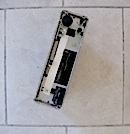 In
Kreuzberg we crossed the Oranienplatz, and walked into the Dresdenerstraße.
There, in the gutter near one of the parked cars I saw an old car cassette
player. When I picked it up I noticed that there was still a tape inside.
The thing was stuck. Impossible to get it out without using a screw driver
or some other tool. So I took all of it ... The tape (#569
in the Found Tape Exhibition) turned out to be very greasy, as if somehow someone
had spilled oil into the player. It was a complete, unabridged and not even broken copy of a cassette
edition of Biz Ayrilamayiz, an album by the popular turkish transsexual
singer Bülent Ersoy.
In
Kreuzberg we crossed the Oranienplatz, and walked into the Dresdenerstraße.
There, in the gutter near one of the parked cars I saw an old car cassette
player. When I picked it up I noticed that there was still a tape inside.
The thing was stuck. Impossible to get it out without using a screw driver
or some other tool. So I took all of it ... The tape (#569
in the Found Tape Exhibition) turned out to be very greasy, as if somehow someone
had spilled oil into the player. It was a complete, unabridged and not even broken copy of a cassette
edition of Biz Ayrilamayiz, an album by the popular turkish transsexual
singer Bülent Ersoy.
° The third stage lead to knowledge.
 Before
heading back to das kleine headquarters we passed at Udo Noll's.
I can't remember what was the reason we did, but the idea proved to be an
excellent one. I might actually have met Udo at Conflux
last year. Or I might have crossed him last month at the Amsterdam PICNIC.
I did not, but it is just to say that Udo's
work would have fitted the one and the other perfectly. In his most recent project he
overlays Google's mapping of our world with an open and growing collection
of located soundfiles, that can be uploaded to radio
aporee ::: maps by anybody from anywhere, provided that that particular 'anywhere' allows
for the use of a telephone or an internet connection. Currently the aporee-maps
database contains more than 3000 soundfiles, attached to over 2300 different
places, all over the world.
Before
heading back to das kleine headquarters we passed at Udo Noll's.
I can't remember what was the reason we did, but the idea proved to be an
excellent one. I might actually have met Udo at Conflux
last year. Or I might have crossed him last month at the Amsterdam PICNIC.
I did not, but it is just to say that Udo's
work would have fitted the one and the other perfectly. In his most recent project he
overlays Google's mapping of our world with an open and growing collection
of located soundfiles, that can be uploaded to radio
aporee ::: maps by anybody from anywhere, provided that that particular 'anywhere' allows
for the use of a telephone or an internet connection. Currently the aporee-maps
database contains more than 3000 soundfiles, attached to over 2300 different
places, all over the world.
When we arrived at his house, somewhere off the Kottbusser Damm, Udo was just about to do some testing for his Tuned City presentation of the project the next day, on thursday july 3th, at Alexanderplatz. During that presentation a live mix of the sounds stored on the Aporee map of the area around the Fernsehturm on Alexanderplatz would be generated by someone going around Alexanderplatz carrying a cell phone equipped with a GPS. The playing of the sounds on the map is triggered by that person and his telephone's passing by the corresponding locations. At this time, up to three mapped sounds can be played simultaneously, and they are mixed together according to the relative position of the phone to the sounds. Thus, obviously, the mix changes while the telephone moves on ...
To test if all was functioning the way it should, Udo sent Simonetta, his companion, out into the street with a GPS enabled handy.
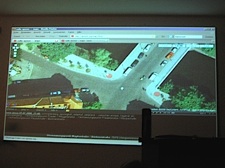 |
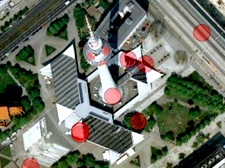 |
We sat back and watched a projection of the map on Udo's wall.
The many sonic ghosts lurking at locations near his house - recordings of sounds that, once, did sound out there - came back
to life loud and clear ...
In 2003, I made a sound
map of the isle of Ameland. Google maps were not yet available then
( ** ). The Ameland map was done in Flash, the attached sounds are mainly
a selection from the dictaphone recordings I made on the island
during my
'geluidjut' residency in may of that year. Compared to Udo's aporee maps, this 'Geluideiland'
technically is pretty primitive. The Ameland 'island of
sounds' is a relatively small and closed collection of (lo-fi) sound recordings from a (very
small) part of the world, all made within the same short timespan. The aporee maps are an open and ongoing collection, to which
continuously sounds are being added, all over the world ...
What to me was a most interesting 'discovery' at the time I did the Ameland map, was the fact
that such a 'soundmap' becomes an interface that turns your collection of sounds into
an instrument: you
can play a soundmap ... which gets especially interesting when the
map allows for the simultaneous playback of several of its soundfiles, and
some form of mixing ...
That evening it was Simonetta who played the aporee soundmap of the neighborhood where Udo and she are living, just by going out for a short walk around the block ...
In the wake of this successful test, for at least a good hour Udo shared with us his passion for maps, and recounted the absolutely fascinating history of surveyors measuring and mapping our world with ever increasing precision. I learned a lot, for instance about Carl Friedrich Gauß's work as a surveyor, who, in 1828, was commissioned by George IV of England to triangulate the then Kingdom of Hanover.
As Udo quite rightly observed: maps are far more than merely convenient tools. In a way they actually produce the territory that they describe. It is largely through maps that we negotiate our world. Many of these maps are 'private: they are mental maps. The creation of shared 'physical' maps, therefore is not only a scientifico-political one, it is also a psychological act: these maps are abstractions that determine and fix our view of the world by providing a canonical and imposed unification of the great diversity of people's 'private' maps.
Power, politics and maps: for much of its history mankind's striving for comprehension and mastery of this world and its universe went hand in hand with a mapping of that world using increasingly precise measurement. It led to what Udo likes to call neuroses of precision: the increasing precision of measurements enables one to make distinctions that before one was not able to make. It therefore creates problems that before were not recognized as such. It was only when our instruments for time measurement became able to distinguish periods of time lasting a second and fractions thereof, that we came up with problems that asked for solutions precise to fractions of a second ...
Measurement creates awareness. This is expressed in a catchy and compact way by the dutch dictum "Meten is Weten", the content ( *** ) of which is, in whatever language, one of the prime credos of western civilization. Udo's view of this quest for precision as neurotic (which, btw, I do not consider as something necessarily negative) I find fascinating, as our means to measure have long surpassed our own human scale, and our capabilities for distinction by way of our proper, biological, senses.
You can listen to extracts of my dictaphone recordings of the evening we
spent at Udo's, which include some of the great anecdotes that he told us
(in german), in the third in my series of radio-dicta-phonic sound reports
that audio-document my stay at Neukölln, Tuned City and das kleine during
the first week of this year's july.
It is called "Neurosen der Präzision".
The fifth audio report is called: "Radio Aporee - Berlin soundmaps". That report
is built exclusively by mix-playing online two of the Berlin soundmaps available
at radio aporee ::: maps.
The first of these is the soundmap of the neighborhood of Udo's house,
that we listened to that wednesday evening. The second one is the soundmap
of the surroundings of the Fernsehturm at Alexanderplatz, where Udo did his Tuned City
presentation the next day.
The aporee map of Alexanderplatz actually contains a couple of recordings that where made there during the Tuned City events of thursday july 4th. Thus at Alexanderplatz you may listen to an extract of "Navigating hybrid spaces via sound", a presentation by Frauke Behrendt, and indeed also to much of Udo Noll's presentation, via the voice of the girl that provided those attending it with a simultaneous translation of Udo's german into english. It is there that you find the aporee map talking about and explaining itself ...
So where will all of this lead to? I for one fully agree with Udo, when he states that we have only seen the very beginning of what eventually will be possible - and therefore eventually will be done - using this kind of memory mapping, of 'tagging locations with media' technologies. Pioneering projects like Udo's radio aporee ::: maps uncover its promises, but of course also point to several of possible pitfalls.
The tagging of locations with sounds, or more generally with whatever 'memories',
is dramatically 'many-to-one': to each tagged point (each 'location') actually
corresponds a (time)line, along which the available recordings are ordered in time.
And therefore what we really have is not one map, but a whole collection
of maps, each one corresponding to a certain period of time; and the larger the number of attached recordings,
the more 'structured' and 'dynamic' (historic, important, rich, 'speaking') locations become. But then how
much importance do we give to the underlying, the visible, geographical
map? Will the map remain as it is? (More or less) 'contemporary' to its viewing? Is it merely symbolic?
Can we continue to tag a satellite image of
Berlin Alexanderplatz taken ten years from now with sounds recorded there
in july 2008? And what in case we do not consider time-based soundmaps,
but maps generated according to some other semantic criterion, like: 'children
playing' or 'traffic sound' or 'street musicians' ...?
In an open, world wide, project like aporee, at some point the number of available
sound files will have become that big, that it will be necessary to access and present
these media and data by means of sub-maps generated according to some criteria.
If historical time is the selection criterion, I think I would like to be able to provide a geographical map that corresponds as closely as possible to the time period from which the recordings stem. A such wish of course may easily lead to one more example of neurotic precision: how and how often does Google update its maps? Is it backing up the successive 'states of our world'? Maybe even daily? Will we eventually be able to access historical full back-up 'states' of the earth by means of a kind of 'Googlemaps Wayback Machine'?
In the end maybe the following will turn out to be the most important and most difficult question of all: should we trust Google?
Is it possible to trust whoever or whatever controls a such 'mapping
power', and the means to determine - hence manipulate - the way in which all of
us view and know the world?
next : un-Tuned City
notes __ ::
(*) You can find another version of that same 'radio
memory' in Rinus' (dutch) novel Aisha. The full text is available
for your reading pleasure as a pdf-file on the web. To find it, just google
the hairdresser's name ... [ ^ ]
(**) Google
maps was introduced early 2005. [
^ ]
(***) Literally this means "to measure is to know", but this translation is hardly as 'catchy' as is
the dutch original. [
^ ]
tags: Berlin, Neukölln, das kleine, soundmap, sound souvenirs, found tapes
# .281.
comments for Neurosen der Präzision ::
|
Comments are disabled |
Read about Berlin on the SoundBlog:
(august 4, 2022) - Berlin: Zero Cohesion (3)
(july 24, 2022) - Berlin: Zero Cohesion (2 = ©)
(july 11, 2022) - Berlin: Zero Cohesion (1)
(november 11, 2021) - A Berlin Reader
(august 05, 2011) - (I can't get no) Immediate Satisfaction (Diktat in Berlin_iii)
(july 31, 2011) - 'Kommt raussi!' (Diktat in Berlin_ii)
(july 29, 2011) - 'Where ist Ausland?' (Diktat in Berlin_i)
(february 07, 2009) - « Mok mok jaha für das kleine in Berlin (Tuned City, Berlin_vi)
(december 23, 2008) - « das kleine, Intiem » (Tuned City, Berlin_v)
(december 08, 2008) - un-Tuned City (foundtaping in Neukölln) (Tuned City, Berlin_iv)
(november 12, 2008) - Neurosen der Präzision (Tuned City, Berlin_iii)
(november 07, 2008) - Cake & Coffee (Tuned City, Berlin_ii)
(october 29, 2008) - Light budget, heavy thinking (Tuned City, Berlin_i)
(october 12, 2008) - Hanna's Sirens (Tuned City, Berlin_o)
(july 01, 2007) - dinges (Back to Berlin, iii_3)
(april 25, 2007) - Fluxissage
(april 12, 2007) - reek or (Back to Berlin, iii_2)
(april 08, 2007) - i feelt (Back to Berlin, iii_1)
(march 07, 2007) - found tapes (Back to Berlin, ii)
(february 27, 2007) - "Bo tuny te..." (Back to Berlin, i)